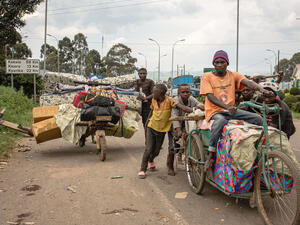Back to school in the world's largest refugee camp
Back to school in the world's largest refugee camp

First day of school for Somali refugees at the new Ifo 2 Primary School in Dadaab, Kenya.
DADAAB, Kenya, September 5 (UNHCR) - The new academic year got under way on Monday in the world's largest refugee camp complex, with some 43,000 Somali children turning up for classes at Dadaab in north-east Kenya.
Some, particularly those who have arrived in the last three months, are going to school for the first time. But enrolment rates among the estimated 156,000 children of school age are relatively low in Dadaab's camps, which have 19 primary schools and six secondary schools.
Many of those entering school were among the more than 100,000 Somali refugees who have arrived in Dadaab since June after fleeing conflict, drought and famine in their homeland, bringing the refugee population here close to 470,000.
"These children are in strong need of the routine and protection that school provides," said Linda Kjosaas, the UNHCR education officer in Dadaab. "Circumstances here are far from ideal and we should be providing them with much more, but children are happy and, talking to their parents, it is clear that they value education highly."
At the recently opened refugee site called Ifo 2, boys played football and girls skipped in the courtyard of a brand new primary school on Monday. "Most of these children have arrived this year from Somalia," said the headmaster, Mohammed Abdullahi Bashir. "We decided to open the school two weeks earlier to give them a chance to catch up."
So far, about 1,100 children have been enrolled at this school and 11 of the school's 24 classrooms have been filled. "Every day more children are enrolling," Bashir added.
Very few of the new arrivals received any formal education in Somalia. To help them cope, UNHCR's partner, CARE, recently began an accelerated learning programme to teach them basic literacy and numeracy skills. Some 1,500 children between the ages of five and 13 benefitted from this programme.
The schools at Dadaab follow the Kenyan education curriculum. There are also private and religious schools, adult literacy centres and four vocational training centres for refugee and local youth.
With the large influx of refugees from Somalia this year, more than half of whom are children, the demand for classrooms, desks, stationery, textbooks and teachers in Dadaab has increased dramatically - at least 75 new schools will need to be built.
Currently, there is only one teacher for every 100 pupils. In some of the schools, teachers work double shifts, teaching one group of children in the morning and another in the afternoon. Most of the teachers are refugees themselves. For teenagers, opportunities to start or continue formal education are few.
Because of overcrowding, most of the refugees arriving from Somalia this year settled outside the three existing camps with little access to basic services. In recent weeks, UNHCR has been transferring these refugees to two new sites. To date, some 30,000 refugees have been relocated to the new sites, where UNHCR is building temporary schools for 14,000 children.
By William Spindler in Dadaab, Kenya








